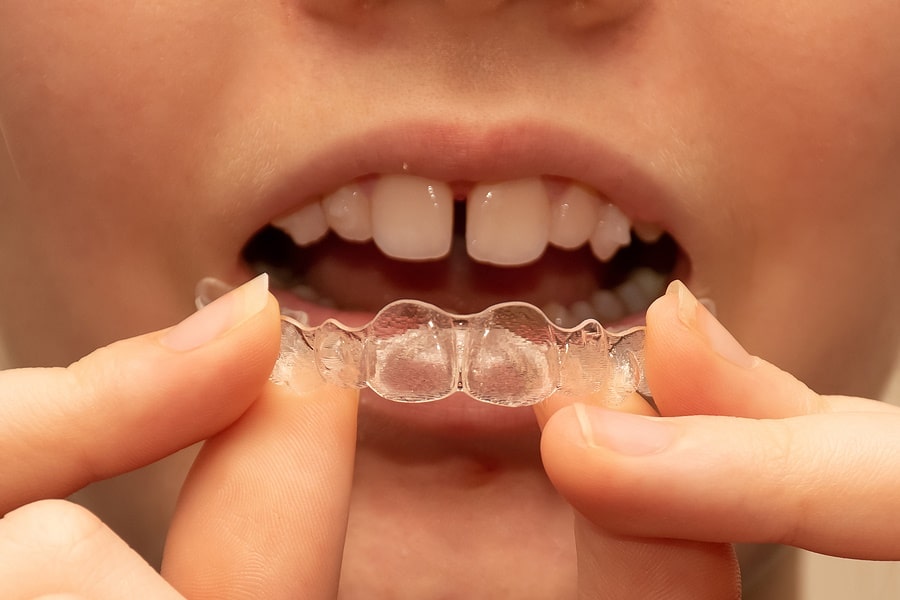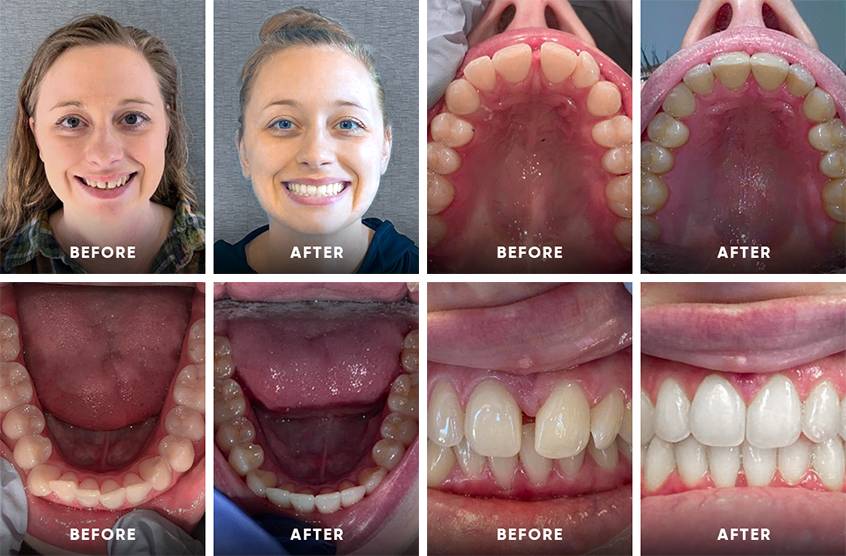The Ultimate Comparison: Invisalign vs. Traditional Braces for Adults
The Ultimate Comparison: Invisalign vs. Traditional Braces for Adults
Blog Article
Invisalign vs. Traditional Braces: Which Choice Is Right for You?
When taking into consideration orthodontic therapy, the choice between Invisalign and conventional dental braces offers numerous important factors that merit cautious analysis. Invisalign offers a discreet option with detachable aligners, while typical braces offer a more visible yet reliable solution for severe imbalance. Each option encompasses unique benefits and drawbacks associated with looks, convenience, treatment period, and price. Understanding these nuances is important for making an informed choice that aligns with your individual preferences and way of living. The inquiry continues to be: which option will ideal fulfill your orthodontic needs and assumptions?
Introduction of Therapy Choices

In contrast, traditional braces contain metal brackets and wires that are bonded to the teeth. This method uses continual stress gradually to accomplish positioning. While effective for complicated orthodontic concerns, conventional dental braces call for routine sees for adjustments and can position obstacles in preserving dental hygiene as a result of the trouble of cleansing about braces and cords.
Both alternatives have their merits, and the option frequently depends upon certain oral conditions, way of life preferences, and client conformity. Inevitably, consulting an orthodontic expert is essential for determining the most suitable treatment plan tailored to individual demands. Comprehending the nuances of each alternative can dramatically affect the general success of orthodontic treatment.
Visual Considerations
A significant aspect affecting the selection in between Invisalign and traditional dental braces is the aesthetic charm each therapy offers. Invisalign aligners are crafted from clear plastic, making them essentially undetectable when worn. This discreet appearance is specifically attracting adults and teens who might feel awkward concerning their orthodontic treatment. The ability to preserve a natural smile throughout the alignment procedure can significantly enhance the person's self-confidence in social and professional settings.
On the other hand, standard dental braces contain metal brackets and cords, which can be more obvious. While developments in orthodontic innovation have actually led to the development of smaller brackets and colored elastics, conventional dental braces still maintain an even more noticeable account. For some individuals, the presence of braces might hinder them from seeking required treatment.
Eventually, the choice in between Invisalign and typical braces might rest on personal choices regarding appearances. Clients who focus on discretion often lean towards Invisalign, while those who are much less concerned about presence may choose for conventional dental braces. Recognizing the visual effects of each choice is essential for making a notified decision that straightens with one's lifestyle and preferences.
Comfort and Convenience

In regards to benefit, Invisalign aligners are removable, allowing people to appreciate their favored foods without restriction and preserve ideal dental health. Brushing and flossing are streamlined, as the aligners can be gotten throughout these routines, whereas conventional braces need cautious maneuvering around wires and brackets.
Additionally, Invisalign's dynamic system permits for less orthodontic sees. Patients usually obtain numerous collections of aligners at the same time, which can improve the treatment process and lower time spent in the orthodontist's chair. In comparison, typical dental braces necessitate normal changes, making them less convenient for those with hectic schedules. Invisalign. On the whole, the convenience and benefit of Invisalign make it an appealing choice for many people seeking orthodontic therapy.
Therapy Duration and Performance
While both Invisalign and conventional braces work in remedying oral misalignments, the period of therapy can vary substantially in between the 2 alternatives. Normally, Invisalign treatment can take anywhere from 12 to 18 months, relying on the complexity of the situation. The clear aligners function by gradually shifting teeth right into their wanted positions, and normal follow-ups with an orthodontist help make certain progress remains on track.
On the other hand, conventional dental official site braces frequently require a longer dedication, typically varying from 18 months to three years. This is because of their fixed nature and using cords and braces, which can be extra reliable for complicated cases and severe misalignments (Invisalign). The therapy performance of typical dental braces is well-documented, as they enable accurate modifications and greater control over tooth movement
Inevitably, the selection in between Invisalign and conventional dental braces might depend upon both the anticipated therapy period and the certain dental issues handy. Consulting with an orthodontist is essential, as they can supply tailored suggestions based on individual needs, guaranteeing the chosen technique lines up with desired timeframes and outcomes.
Price Contrast and Insurance Policy Alternatives
Expense plays a significant duty in the decision-making process for people taking into consideration orthodontic treatment, whether choosing Invisalign or standard braces. Usually, the cost of Invisalign arrays from $3,000 to $8,000, while conventional dental braces commonly cost in between $2,000 and $6,000. Elements affecting these prices include the intricacy of the case, the period of treatment, and geographical location.
Insurance protection can considerably influence out-of-pocket expenses. Several dental insurance policy plans provide partial insurance coverage for orthodontic treatments, however the specifics can differ commonly. It is critical for individuals to assess their insurance policy plans to determine the extent of protection for either option. Typically, typical braces may be extra often covered by insurance policy plans compared to Invisalign, which some insurers categorize as a cosmetic treatment.
In addition, several orthodontic practices provide versatile layaway plan, making both treatment options much more obtainable. People should inquire about prospective funding choices and discounts for upfront payments. Evaluating the total cost, including insurance benefits and layaway plan, is important for making a notified choice that lines up with both aesthetic preferences and budget considerations.

Conclusion
In summary, the choice in between Invisalign and standard braces pivots on multiple factors, including visual preferences, comfort, treatment period, and expense. Invisalign uses a discreet, removable alternative that facilitates dental health and nutritional versatility, while standard braces might be preferable for why not check here complicated dental problems and typically come with a reduced cost point. Inevitably, appointment with an orthodontist is necessary to assess individual scenarios and identify the most ideal treatment alternative for accomplishing optimal oral alignment.
When considering orthodontic therapy, the choice in between Invisalign and conventional dental braces provides numerous crucial factors that merit careful examination.Comparing Invisalign and standard braces exposes distinct treatment alternatives for orthodontic adjustment.While both Invisalign and typical braces are reliable in fixing oral misalignments, the duration of therapy can vary dramatically between the two choices.Expense plays a substantial role in the decision-making procedure for individuals taking into consideration orthodontic therapy, whether opting for Invisalign or standard dental braces.In summary, the option in between Invisalign and traditional braces pivots on multiple elements, consisting of visual preferences, comfort, treatment period, and price.
Report this page